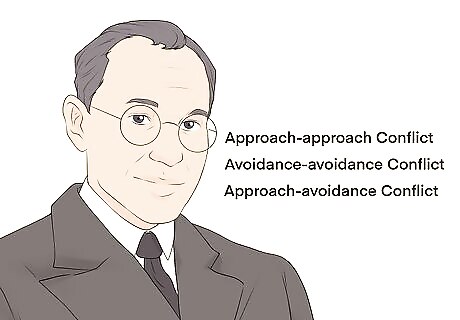
views
- Avoidance-avoidance conflict is when you’re given 2 unpleasant or “bad” choices to choose from.
- An example of AV-AV conflict would be choosing between 2 medical treatments that don’t promise a cure.
- Overcome conflict by weighing your decisions, doing research, and asking for help from someone you trust.
What is avoidance-avoidance conflict?

Avoidance-avoidance conflict is when you’re faced with 2 unpleasant choices. When there’s a conflict, you essentially have to choose between 2 things. In avoidance-avoidance conflict (AV-AV), both choices are undesirable, meaning that you have to choose between the lesser of 2 evils. This can make decision-making difficult and often leads to conflict avoidance or procrastination (with the hopes that a better outcome will come about). Take a look at these examples: Getting diagnosed with breast cancer and having to choose between 2 treatment options that don’t guarantee remission: chemotherapy or a double mastectomy. Disliking a job and choosing between quitting and being unemployed or staying and getting paid. Starting a diet and choosing between eating at a business meeting or being the only one not eating. Voting for a candidate who values the environment or the people.
How do you overcome conflict?

Overcome conflict by thinking through your decisions carefully. Decisions can often be difficult to make, especially when you’re dealing with avoidance-avoidance conflict. Each choice on the table isn’t ideal, yet you have to choose one or the other. To make a decision, try these tricks: Make a list of pros and cons for each choice. Research each choice (if applicable) and learn more about each potential outcome. Be aware of your emotions and how a potential choice makes you feel. Talk to a loved one about the choices and situation. Communicate your wants and needs to a doctor or health care professional (if applicable). Avoid delaying your decision, as this could cause you to worry more.
How to Deal with Conflict Avoidance

View conflict positively. Instead of thinking of conflict as a scary thing, think of it as a learning experience. As psychologist Liana Georgoulis says, “By shifting your thinking towards thoughts that are more positive, you will positively influence your emotions.” See conflict as an opportunity to learn something new, share your feelings, and connect with someone.

Practice saying “no.” Help ease yourself into conflicts by saying “no” more often to little things. The more boundaries you set, the easier it’ll be to express yourself during conflicts. This can look like saying you can’t stay late at work or saying “no” to eating out with friends.

Try deep breathing techniques. Learn to manage your anxiety and stress around conflicts by breathing deeply. When your nerves start to rise, inhale for 5 counts, hold for 5, and then exhale for 5.

Start a journal. Keep a notebook where you can write down all your deepest thoughts, worries, and fears. If you know a conflict is approaching, take some time to write about it. Putting your thoughts on the page can help ease your mind. Don’t think, simply write whatever comes to mind first!

Focus on the present moment. When you feel stuck or overwhelmed, keep your mind on the here and now. What choice will help you in the current moment?

Talk to a therapist. When in doubt, reach out for help! A therapist or counselor can help you identify your fears, handle your anxiety, and build your communication skills. They might ask your questions related to your upbringing or relationships to focus on why you may be avoiding conflict.
Are there other types of conflict?

According to Kurt Lewin, there are 3 types of conflicts. German-American psychologist Kurt Lewin came to the conclusion that there are 3 main types of interpersonal conflicts: approach-approach conflict, avoidance-avoidance conflict, and approach-avoidance conflict. These conflicts occur within you when you’re handed 2 options. Approach-approach conflict (AP-AP) occurs when you’re given 2 desirable options that you like equally. Avoidance-avoidance conflict (AV-AV) happens when you have 2 options you despise equally. Approach-avoidance conflict (AP-AV) is when you can clearly see a positive and negative option.




















Comments
0 comment